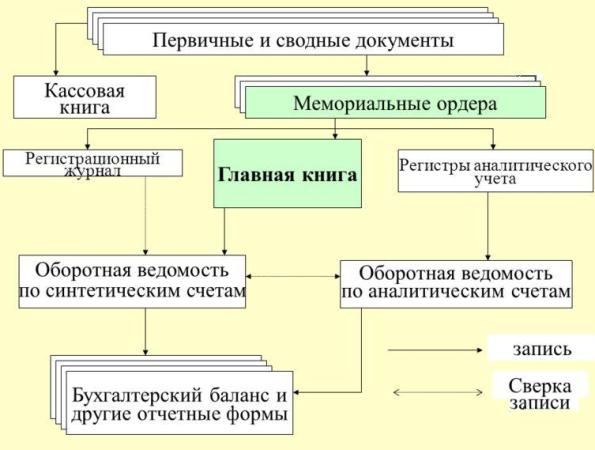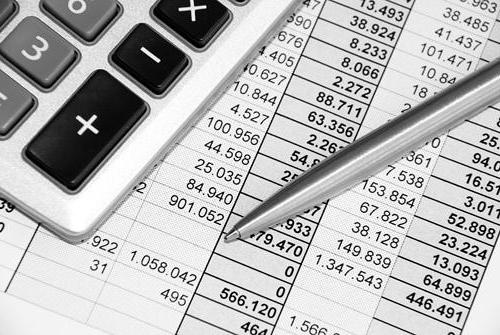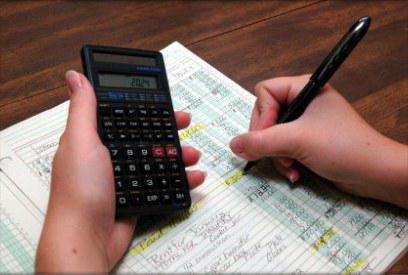In order to obtain the necessary indicators of the financial and economic activities of the enterprise, it is necessary to group and generalize the data contained in the primary documents in a certain way. This procedure is carried out using accounting registers.
accounting register- this is a way of registering, organizing and displaying accounting information on tangible media.
Accounting registers are designed to systematize and accumulate data contained in primary documents accepted for accounting, and to reflect accounting information on accounting accounts and financial statements.
Traditionally, accounting registers were represented by paper tangible media, made in the form of tables. Under the conditions of using personal computers, the concept of an accounting register has been significantly expanded. Part of the information necessary for management is issued in electronic form as videograms. In this regard, a clear distinction is required between the concepts of "accounting register" and "material carrier" of accounting information.
Under the conditions of computer processing of accounting data, several accounting registers can be obtained (printed) on the basis of the same material carrier (usually magnetic).
Fixing information about business transactions in accounting registers is called accounting registration. Accounting registration is an important and responsible area of accounting work. The quality of accounting depends on the correctness of the entries in the accounting data registers contained in the primary documents. In the conditions of accounting automation, accounting registration is carried out automatically.
Accounting registers are classified according to the following main features:
1) in appearance;
2) by appointment;
3) according to the degree of generalization or volume of content;
4) according to the form of construction.
1. Appearance distinguish between accounting books, cards, free sheets, machinograms, videograms.
Account books are tables firmly fastened together with special graphing. All pages in the accounting book must be numbered, and in some (cash book) laced and sealed. On the last page of the book, signed by the head of the enterprise and the chief accountant, the number of numbered pages is indicated and a seal is put. The advantage of books is that it is impossible to replace individual pages. The disadvantage is low mobility, only one person can work with books. It is impossible to group the data in the required section and apply at least partial automation of accounting work.
Cards- these are separate sheets of thick paper with a special engraving. They come in standard sizes for easy storage in filing cabinets. The advantage of check cards is their great mobility in terms of grouping data and accounting work. You can apply partial automation of accounting. The disadvantage is that cards can be replaced.
Loose sheets are separate sheets of non-thick paper with a special engraving. Their difference from cards is in their large size and storage methods. They are stored in folders. The use of free sheets is promising, since they can be filled in and processed using personal computers.
Machinograms and videograms- these are special registers obtained as a result of computer processing of accounting information. The information contained in them is grouped according to certain criteria, subdivided into totals of different degrees: private, intermediate, general and summary. Machinograms are received on paper in the form of printed tables, and accounting information is displayed on the monitor screen by means of videograms, i.e. the latter are its light reflection.
At present, due to the widespread introduction of personal computers into accounting practice, there is a great similarity between machine diagrams and free sheets. The main difference may be that the accounting registration on free sheets, as a rule, is done manually, and in machine programs - automatically.
2. By appointment accounting registers are divided into:
a) chronological;
b) systematic;
c) combined.
Chronological- these are registers in which entries are made in a calendar (chronological) sequence in order to control the incoming primary documents and identify the total amount of business transactions. An example is a registration journal or register of documents. Registration logs can be kept both on paper and magnetic media, in the latter case information is displayed in the form of videograms on the monitor.
Systematic registers are intended for records of economic transactions that are homogeneous in terms of economic content, as a rule, according to accounting accounts. An example of a systematic entry register is the General Ledger.
Chronological and systematic registers are maintained in parallel and their results are periodically compared with each other.
Combined are characterized by a combination of both chronological and systematic records. They appeared as a result of accounting rationalization. An example of a combined ledger is order journals.
3.By degree of generalization (volume of content) accounting registers are classified:
a) synthetic
b) analytical;
c) combined.
V synthetic registers, all entries are kept in a generalized form, as a rule, in sum terms. An example is the General Ledger.
V analytical registers records are kept in more detail. They indicate summary operations. Entries in the registers of analytical accounting are kept in natural meters and in monetary terms.
Analytical registers, in turn, are subdivided:
a) on contract accounts;
b) for quantitative-sum;
c) on polygraphs.
Contractors are intended for separate accounting debit and credit turnover. These are, as a rule, books where personal accounts are opened for settlements with counterparties, entries are made in monetary terms.
Quantitative-sum registers are designed for keeping records and records by quantity and amount. These registers are used for entries in the accounts of materials, finished products, goods, etc.
Multigraph registers are designed to account for individual elements or items, which are understood as certain types of expenses. These are registers for accounting for production costs and distribution costs.
V combined registers combined synthetic and analytical accounting. Order journals are an example.
4.According to the form of construction, registers are divided into:
a) one-sided;
b) on bilateral;
c) on tabular;
d) on chess.
Unilateral registers on one side have columns reflecting the debit (income) of the account and credit (expense). As an example, there may be registers designed to account for material values.
bilateral registers differ from one-sided in that the debit part is on one (left) side of the expanded sheet, and the credit part is on the other (right). In bilateral registers, both parts have the same form and the same indicators.
Schematically, the form of a one-way register looks like this:
Bilateral register form
| Debit | Credit | ||||||
| date | Document No. | Sum | date | Document No. | Reason (content of operation) | Sum | |
Tabular or the multigraph form of the accounting register is characterized by the fact that additional columns for decoding are given for debit or credit.
Table register form
| date | Document Number | Reason (content of operation) | Debit | Credit | Incl. debit account | |||
Chess the form of accounting registers is designed to combine debit and credit entries by using a special graphing vertically and horizontally. It makes it possible to reduce the number of records and combine analytical accounting with synthetic accounting. According to the chess form, some magazines-warrants are built.
Chess register form
| From credit accounts | Depreciation | materials | Salary | etc. | Total | ||
| To debit accounts | per month | year to date | |||||
| Account number (name) | Record basis | ||||||
| Depreciation | Fig.2. General scheme classification of accounting registers |
Business transactions after their completion should be reflected in accounting. To obtain the necessary information about economic activity, all the data contained in the primary documents should be grouped according to their economic content in the accounts. Such an entry in the accounts is carried out in accounting registers. Reflection of business transactions in accounting registers is the second stage of accounting work.
Accounting registers - these are special tables (forms) for reflecting in them business transactions recorded in primary documents.
Registers are intended for accumulation, grouping and systematization of accounts of homogeneous business transactions contained in documents, serve the purposes of monitoring, managing and analyzing the financial and economic activities of organizations and are used to compile established reporting forms.
Due to the fact that there are many accounts and registers, a large number of accounting registers are classified:
by purpose and amount of information (volume of content): synthetic, analytical, combining synthetic and analytical accounting;
by type of account : chronological, systematic, combined;
in external form : free sheets, cards, books, typescripts;
by structure (graphing form) : one-sided, two-sided, multigraph;
on a material basis : paper and paperless registers.
Registers synthetic accounting designed to record business transactions on synthetic accounts. Entries in these registers are kept without explanatory text, in a generalized form and only in monetary terms.
Registers analytical accounting are intended and used to reflect homogeneous operations on separate analytical accounts. Each transaction is recorded quite fully, not only in monetary terms, but also in kind.
registers, combining synthetic and analytical accounting , increase the reliability and clarity of accounting. In these registers, separate lines are intended for analytical accounting, and the total data of all entries are indicators of synthetic accounting.
Chronological registers used to record transactions in chronological order, i.e. in the order in which they were made (most often in the order in which documents were received by the accounting department) without grouping them by accounts.
V systematic registers homogeneous business transactions are systematized according to the accounts of synthetic and analytical accounting. An example is the general ledger, which records the turnover for all synthetic accounts, indicating the corresponding accounts.
Combined registers combine chronological and systematic records.
Loose sheets (statements) are separate sheets or several fastened sheets. These are order journals or statements. They open for a month. Some of them have inserts. Stored in folders.
Cards - these are also free sheets, but not fastened together. They are stored in boxes in a particular system. A set of cards that are similar in purpose is called a card index.
Account books are used to register business transactions on both synthetic and analytical accounts. In accounting books, all sheets are laced, numbered, sealed and signed. The book is drawn up at the beginning of the year and maintained throughout it.
typography - an accounting register obtained when processing documents on a PC. Their forms are diverse and depend on the purpose and content of the objects considered in them.
An important step in the formation of reliable accounting information is accounting technique of business transactions . Reflection of business transactions in accounting registers should be carried out in a certain order on the basis of executed and processed documents.
Recording business transactions in registers is called posting transactions . Posting is made on the basis of the correspondence of invoices on documents (document account assignment).
Certain account methods, which can be classified according to the following criteria:
by the nature of the record : unigraphic and digraphic;
systematization : chronological, systematic, combined (synchronistic);
by image : in the form of a formula, in the form of a scheme (using "T" - accounts), in the form of a matrix;
by number of copies : simple (one-time), copy (reusable);
by way of filling : manual and machine entries.
Unigraphic notation is only a one-sided entry, i.e. a business transaction is recorded only in debit or only in credit of the account (single entry). Unigraphic records are used to keep records on off-balance accounts, which reflect the property temporarily located at the enterprise and not belonging to it.
Digraphic record characterized by the fact that each business transaction is reflected in the debit of one and the credit of other accounts (double entry). In accounting practice, digraphic records, depending on the relationship of corresponding accounts, are divided into the following types:
Simple accounts are characterized by the fact that the debit of one account and the credit of another account reflect a business transaction in the same amount. V complex account the debit of one account can correspond with the credits of several accounts, or, conversely, the credit of one account can correspond with the debits of several accounts. In this case, the sum of debit and credit entries of different accounts must be equal. Reversal entries are corrective entries produced by the "red storno" method. These records are widely used in accounting practice. Reverse Entries are used to correct incorrectly indicated correspondence of accounts by changing the places of debit and credit. However, in practice, such records are not widely used, as they overestimate the turnover on the accounts.
Accounting registers are an integral part of the organization's accounting, which serves to systematize and save data from primary accounting documents.
Accounting registers are designed to reflect business transactions in accounting accounts. Previously, information from accounting registers was a trade secret.
Forms of accounting registers
Until 2013, the forms of accounting registers were uniform and mandatory for use by all business entities.
These forms were featured in the Albums of Uniform Forms. Currently, the forms of accounting registers are approved by the head of the enterprise.
However, the legislation provides for a list of mandatory information contained in the registers:
- register name;
- the name of the economic entity filling in the register;
- period of compilation or maintenance of the register;
- chronological or systematic classification of accounting objects;
- unit of measurement and transaction currency;
- an indication of the positions responsible for maintaining the register;
- Name and signatures of responsible persons.
Forms of accounting registers are established by law and can be taken from official sites, they can be downloaded from the Internet, search using search engines.
Classification of accounting registers

Accounting registers are classified according to purpose, generalization of information and type. According to their purpose, registers are divided into
- chronological,
- systematic,
- synchronistic (combined).
In chronological registers, the facts of economic activity are recorded as they occur. Examples of chronological accounting registers are registers and various registers.
Data in chronological and systematic registers complement each other
Systematic registers are filled in for certain accounts, which include business transactions. An example of a systematic register is a balance sheet.
If the register includes chronological and systematic records, then it refers to combined synchronous registers. An example of such an accounting register is the Journal-Main.
The use of synchronous registers makes the information in them more visual.
Thus, the sum of turnovers in chronological registers is equal to the debit or credit turnovers of systematic registers. This relationship is called the Mendes rule.
According to the generalization of information, registers are divided into synthetic and analytical.
- In synthetic registers, transactions are recorded only with the indication of the date and amount.
- Analytical accounting registers are accounting forms in which analytical information is systematized, that is, not only the details of the operation, but also its brief content.
Business entities also use complex accounting registers that combine the principles of synthetic and analytical registers, as well as chronometric and systematic factors.
When using such forms, the totals for synthetic and analytical accounts automatically match, which frees you from additional reconciliation of turnovers for different statements.
In appearance, registers are divided into books, cards, free sheets and machine media.
- The book is a register, which is mandatory laced, numbered and sealed with the seal and signatures of responsible persons.
- A card is a register in the form of a typewritten table.
- A free sheet is a register in the form of a table to be filed. To account for cards and free sheets, registers are maintained in order to exclude register substitution or, if necessary, restore a lost document.
- A machine medium is an electronic document stored on a magnetic medium and certified by an electronic signature. When using machine media, the information should be printed in a timely manner.
The reliability of the information reflected in the accounting registers is ensured by responsible persons.
If an error is found in the register, the responsible person makes the correction, indicating the date the correction was made and affixes it with his signature.
The correction is made by crossing out the incorrect information once so that it remains legible. The above information is correct.
For each correction in the registers, written explanations of the responsible person must be given.
Accounting register sample document turnover scheme 
If you find an error, please highlight a piece of text and click Ctrl+Enter.
The primary documentation received by the accounting department is necessarily subjected to verification both in form and in content. The correctness and completeness of registration, the presence of mandatory details, the legality of recorded transactions, the logical connection of indicators are evaluated. After that, the registration and grouping of data is carried out. Information is recorded in the system of analytical and synthetic accounts. For this purpose, accounting registers are provided: forms of accounting. Let's consider further what they can be.
General information
Accounting registers are special tabulation tables. They are formed according to the economic grouping of information about property and sources. Forms of accounting registers are necessary to reflect ongoing business transactions in the relevant accounts.
Classification
Existing types of accounting registers are divided according to purpose, appearance and method of summarizing data. According to the first criterion, documents are distinguished:
- Systematic.
- Chronological.
- Combined synchronous.
Chronological accounting registers are documents in which records of the facts of economic activity are made as they are carried out, without other systematization. These include, for example, registries. Entries are made in systematic tables according to grouping characteristics - accounts. Information from these two types of registers should complement each other. Therefore, the sum of turnovers for chronological documents is always equal to the sum of credit/debit figures from systematic tables. When both chronological and systematic records are entered into one register, it is considered combined (synchronistic).

Summarizing information
On this basis, accounting registers are divided into differentiated and integrated. Consideration of data can be carried out inductively, that is, to the general from the particular. In this case, information integration takes place. Also, generalization can be carried out deductively: to the particular from the general (from reporting to primary documentation). In this case, there is differentiation of information.
Appearance
According to this criterion, the following accounting registers are distinguished:
- Books. They are a document marked in a special way, laced, bound and signed by a responsible person (chief accountant).
- Cards. They are forms printed as tables.
- Free sheets. Such accounting registers are tables placed on forms that are subject to binding. Such sheets are considered an alternative to books and cards. These papers are kept in folders. For them, as well as for cards, registers should be maintained.
- Machine media. These accounting registers have technical features. In this case, the data are placed not on paper, but on electronic media (drive).
Consider the main accounting registers separately.

Books
These registers contain information about the facts of economic activity (operations). It is distributed according to the specifics of the objects. Books must be designed in accordance with the requirements of the rules. Besides the fact that they must be bound, laced and numbered, the number of pages must be indicated on the back of the last sheet. Under the indicated number, the signatures of the head of the enterprise and Ch. accountant, stamped. Typically, books are used in cases where the objects of observation are in small numbers. But for a number of categories (for example, for cash transactions), enterprises keep records in the cash book, where all events are entered. The general ledger summarizes all objects.

Cards
This is a fairly convenient form of registers. They can be sorted, they are distinguished by visibility and accessibility when handling. Externally, the cards may be different. The most common types include: contract, multi-column and inventory. The first ones are filled in on one side, since the debit and credit columns are located side by side. The presence of parallel columns allows you to see the state of settlement operations of the enterprise. Material values are taken into account in inventory cards. They enter the column "Remainder". It reflects the amount of funds remaining after the registration of a business transaction. Therefore, in each account there are columns for receipts, expenses and balances. The heading contains the standard (limit) for the stock. Its presence allows you to easily determine whether these funds are present in the enterprise in larger quantities than expected. If it turns out that there are fewer of them, then the difference with the limit is set. In multi-column cards, the operations of the economic life of the company are taken into account with the allocation of components in columns. This, for example, is relevant for cases where a fact is recorded in complex amounts, that is, payment of various company expenses is reflected.

Loose sheets
They are larger than cards. Accordingly, the volume of information that is reflected in them also increases. In accounting practice, free sheets are different statements. They are used to generalize homogeneous data. For example, they reflect depreciation on fixed assets, the release (shipment) of goods, and so on.
Machine media
They can be floppy disks, disks, etc. When using such registers, the enterprise must make paper copies of documents. This is done, among other things, at the request of the authorities authorized to exercise control, as well as the court and the prosecutor's office. Media features determine the order in which information is arranged. Their use is determined by the mass nature of the operations carried out, the specifics and volume of accounting objects and other factors.

Conclusion
The correctness of recording business transactions in accounting registers is ensured by the persons who compiled and signed them. In the process of storing such documentation, it is necessary to ensure the protection of information from unauthorized correction. Corrections of errors in accounting registers must be justified and confirmed by the signature of the employee who made the changes. In this case, the date of correction must be indicated. In accordance with the Federal Law "On Accounting", the information contained in the registers is classified as a commercial secret. Persons who have access to such documentation are required to keep it. For the disclosure of information, violators are liable in accordance with the norms of domestic legislation.
perform the functions necessary for any company: fixing, grouping, storing information about business facts. The number of items is quite large, which is explained by the peculiarities of accounting for various objects and facts of economic activity when doing business.
Categories of accounting registers and forms
Accounting registers act as a basic tool for summarizing data from primary documentation, used later to make entries in the relevant accounts and to generate indicators for financial reports. Making entries in accounting registers, the specialist not only processes the primary documentation, but also analyzes the content of the business transactions confirmed by them for the legality and correctness of the display of actual events.
Depending on the method of data capture accounting registers are classified:
- systematic - allow you to collect information in relation to accounting accounts, such, in particular, include the general ledger;
- chronological - designed for continuous recording of data in the order of receipt of documents without breakdown by accounting areas, they include various magazines and books;
- combined - combine the possibilities of grouping data in chronological order, they include order journals and statements.
Depending on the order of the data for accounting registers the following breakdown is provided:
- filled on one or two sides of the sheet;
- chess statements - with data located in tables at the intersection of rows (according to the debit of the account) and columns (according to the credit of the account).
According to the nature and method of generalizing information, the following are distinguished list of accounting registers:
- Analytical - serve to accumulate analytical information on the company's synthetic accounting accounts, with their help, the movement of material assets, the timeliness of settlements with partners, etc. are tracked.
- Synthetic - allow you to receive final, final, non-detailed data on the amounts collected on the accounts. One of these is the main book.
- Combining the functions of the above types of registers, they are typical for journal-order system accounting.
If we evaluate appearance accounting registers, among them are:
- Card forms - are sheets with blank tables printed on them, these include contract, multi-column and inventory, for example, a card for accounting for fixed assets.
- Magazines, books - bound, lined sheets in hard or soft cover, on which, as a rule, the name and period of register filling are indicated. Similar pages accounting registers are numbered, laced and fastened on the last sheet, where the chief accountant's signature is put.
- Large format sheets - reminiscent of enlarged cards, they include accounting records and some order journals.
- Automated printed registers - are created using specialized electronic accounting databases, based on the information accumulated in them.
List of the most commonly used registers
At present, most unified forms of accounting registers are not required to use. This is confirmed by the information disseminated by the Ministry of Finance of the Russian Federation dated 04.12.2012 No. PZ-10/2012 in connection with the entry into force of amendments to the Law “On Accounting” dated 06.12.2011 No. 402-FZ. However, this rule does not apply to individual forms put into effect by specially authorized bodies. The only requirement for registers was the availability of a list of required details in the forms developed by companies.
Registers, books, cards put into effect within the company must certainly be mentioned in accounting policy companies, and those forms that will be used Chief Accountant and his subordinates must be approved by the head of the organization without fail. Companies whose source of financing is the state budget, as well as the main shareholder of which is the state, are required to use the forms in accordance with the order of the Ministry of Finance of the Russian Federation of March 30, 2015 No. 52n. Commercial organizations, in turn, quite often create their own forms based on the forms from the order.
To illustrate what was written above, we give an excerpt from the said order:
|
Accounting cards: |
|
the main asset; |
|
groups of fixed assets; |
|
Vedomosti: |
|
turnover balance; |
|
· turnover on non-financial assets; |
|
data accumulation. |
|
· home; · Analytical accounting of deposited amounts of wages. |
|
accounting for transactions on various accounts; |
|
accounting for the movement of other property. |
|
· cards; |
|
· transfer of documents; |
|
accounting for securities; |
|
deposited amounts; |
|
Posting and writing off expenses. |
|
Cards: |
|
· multiline; |
|
accounting of funds and settlements; |
|
Accounting for funds loaned; |
|
control over the movement of valuables; |
|
fixing payment documents for execution. |
|
Inventory cards for OS accounting; |
|
Inventory. |
|
Vedomosti: |
|
deviations from the results of the inventory; |
|
· Registration of non-invoiced deliveries. |
How to draw up an order on approval of registers - sample
To confirm the legality of the application of the forms, a order on approval of accounting registers companies. The main developer of forms and samples of accounting registers the chief accountant of the company acts, and their head of the organization approves.
This administrative document will be mandatory required by controllers from the Federal Tax Service during the audit. Based on the order types of accounting registers reviewers will request the forms they are interested in. Although today most accounting processes are carried out using electronic databases, in paragraph 6 of Art. 10 of Law No. 402-FZ contains a clear indication of the need to store registers in printed and signed form or in digital format with the obligatory presence of a digital signature. Based on this, the forms requested by the tax authorities will have to be generated in paper form or in electronic format, but with the indispensable presence of a signature.
In most cases, the specific name of the register is indicated for each account. To do this, special tables are created that indicate the account, the name of the form and the person who is responsible for its regular execution. An example is the following version of such a table.
An example of fixing accounting registers in an order for an organization or accounting policy
***
The presence of registers that provide a comprehensive record of property and liabilities is mandatory for the full functioning of the accounting of any organization. Without them, it will not be possible to prepare the final financial statements for all interested users. Also, this information is used to provide statistical data, management accounting and current analysis of the results of the company.
Companies that are not related to the state and budgetary sector are allowed to develop their own forms of such documents. They must be approved by the head of the organization and they must contain all the required details from the list established by law. State-owned companies are required to use unified forms approved by the RF Ministry of Finance for these purposes. In most cases, the latter serve as the basis for private companies to create their own accounting forms.





